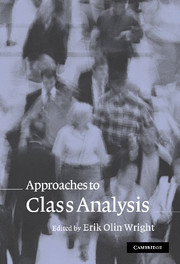Book contents
- Frontmatter
- Contents
- List of figures
- List of tables
- List of contributors
- Introduction
- 1 Foundations of a neo-Marxist class analysis
- 2 Foundations of a neo-Weberian class analysis
- 3 Foundations of a neo-Durkheimian class analysis
- 4 Foundations of Pierre Bourdieu's class analysis
- 5 Foundations of a rent-based class analysis
- 6 Foundations of a post-class analysis
- Conclusion: If “class” is the answer, what is the question?
- References
- Index
6 - Foundations of a post-class analysis
Published online by Cambridge University Press: 22 September 2009
- Frontmatter
- Contents
- List of figures
- List of tables
- List of contributors
- Introduction
- 1 Foundations of a neo-Marxist class analysis
- 2 Foundations of a neo-Weberian class analysis
- 3 Foundations of a neo-Durkheimian class analysis
- 4 Foundations of Pierre Bourdieu's class analysis
- 5 Foundations of a rent-based class analysis
- 6 Foundations of a post-class analysis
- Conclusion: If “class” is the answer, what is the question?
- References
- Index
Summary
Contemporary class theories and analyses are grandchildren of Marxism. As noted by Wright in the Introduction, they share with their classic antecedent a broad explanatory aspiration. They aim at charting and explaining the structure of inequality, especially in economically defined life chances, by linking these inequalities with the patterns of property and employment relations. They also aim at identifying key conflict-generating economic cleavages, especially those that underlie transformative social struggles. In doing that, they combine and compete with a number of alternative – that is nonclass – analytic and theoretical constructs. The latter include concepts and propositions derived from the Tocquevillian, Durkheimian and Weberian theoretical heritage: occupational theories of stratification that focus on social division of labor and occupational closure; “status” theories of inequality identifying value-conventional sources of racial, gender and ethno-national inequality and conflict; and theories concentrating on political power, organizational hierarchies of authority and the accompanying social tensions and struggles. This competition is complicated by partial convergence between the competitors. As the preceding chapters show, the classic Marxist heritage has undergone a number of reformulations that blur the boundaries between the original analytic distinctions of class, occupation, status, and political power. Therefore any rendition of an analytic and theoretical confrontation between class and nonclass accounts of social inequality, division and conflict has to rely on some – often contested – definitional distinctions.
- Type
- Chapter
- Information
- Approaches to Class Analysis , pp. 152 - 179Publisher: Cambridge University PressPrint publication year: 2005
- 21
- Cited by



